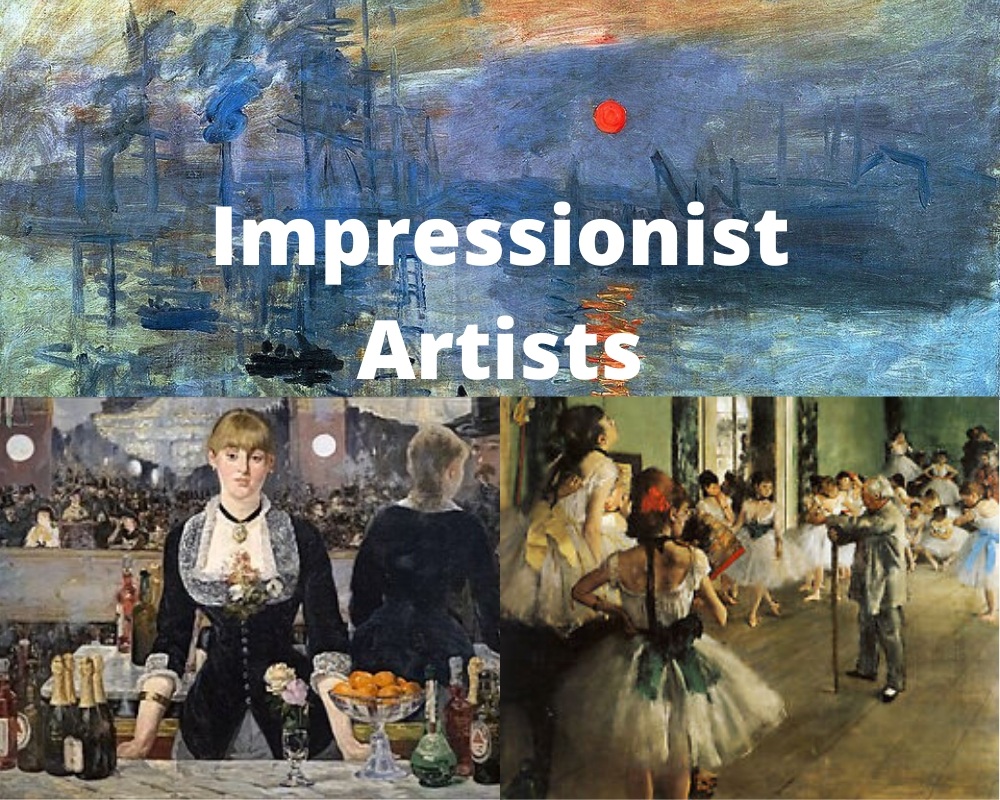The impressionist artists in this list were rejected by the art critics of the day.
Impressionism was a massive departure from the traditional realistic works at that time.
More and more everyday scenes and people became their subject matter as opposed to the conventional works and portraits of upper class patrons.
The style was exemplified by brighter colors and little black used by the artists, different changes in color and tone gave form and structure to individual objects rather than distinct lines.
Who Were the Main Impressionist Painters?
The main impressionist artists were:
- Claude Monet
- Édouard Manet
- Edgar Degas
- Pierre-Auguste Renoir
- Camille Pissarro
- Mary Cassatt
- Alfred Sisley
Below you will find a list of famous impressionist artists and their important paintings.
Famous Impressionist Artists
1. Claude Monet
Claude Monet, born in 1840 Paris, was an ambitious French artist and regarded as one of the most important founders of impressionism.
In fact, the term impressionism was coined after his painting Impression, Sunrise.
During his youth, he became known for his charcoal caricatures, but it wasn’t until Eugene Boudin became his mentor that he learned to use oil and outdoor techniques.
After traveling for many years throughout his childhood, Monet returned to Paris. During this time, he met many fellow eventual impressionists such as Édouard Manet whom he befriended.
While in Paris, he was drafted for the military, but his aunt was able to get him released from the army with the condition that he complete a course at an art school.
After many years of hardship and success, Monet died from lung cancer at 86, requesting a small and intimate funeral.
His famous early work was The Woman in the Green Dress, which depicted his wife, Camille Doncieux, whom he used as a model.
Most of Monet’s famous artworks focused on landscapes and seascapes of the French countryside.
He would work on the same scene many times in order to capture the passing of time and the changes in light and color.
Among the impressionist he is considered to be the most famous artists of the style.
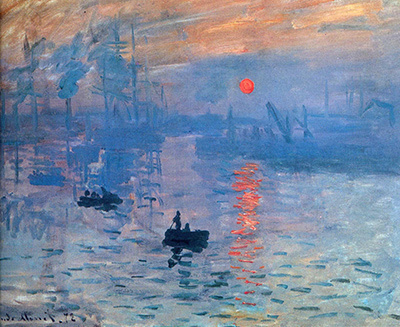
The most famous of all impressionist paintings is Impression Sunrise by Claude Monet is responsible for the actual name Impressionism.
Monet painted six separate canvases that depicted the port of Le Havre, France which is his home town.
Impression Sunrise is the most well known of the series and was displayed along with works by other artists in 1874, this new style of artwork had many critics.
The group of what become the impressionist artists in question were rejected from the Paris Salon which drove them to create their own exhibition to showcase their work.
The work typified the new art movement. It’s name is synonymous with the style.
It does not embrace a lot of the style of other impressionist artworks as it displays a restrained use of color and brush strokes.
2. Édouard Manet
Édouard Manet was pivotal in the shift from realism to impressionism. While revering realism, his controversial and bold impressionist works drew great criticism and admiration among artists of his time.
Born in 1832 to a wealthy family in Paris, he aspired to become an artist from an early age.
With encouragement from his uncle, he was mentored by Thomas Couture.
To educate himself, he traveled to Italy, Germany, and the Netherlands which impacted his style and artistic concept.
Manet focused on contemporary themes, but moved to historical and religious depictions.
His first piece that received recognition was The Spanish Singer.
Featured in the Paris exhibit known as The Salon and was criticized as “slapdash”, but his bold choices in subjects earned him greater controversies and notoriety.
His works like The Luncheon on the Grass and Olympia depicted paintings of women who were naked and received heavy backlash for being immoral and vulgar by many of his conservative contemporaries.
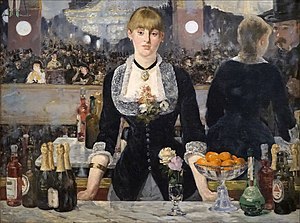
Most of his later works were still life’s and drew little criticism, although his last work , A Bar at the Folies-Bergere, depicts a scene in a nightclub of the same name and has stirred conversation for over one-hundred years.
Édouard Manet died of syphilis at the age of 51 in 1882 after he completed A Bar at the Folies-Bergère which depicts one of the types of scenes that he would become known for every day leisure scenes.
It is the artists final large work and many consider it to be one of his best.
The image has posed more questions than it answered as the perspective created by the mirror has been debated as to it’s accuracy.
3. Egdar Degas
Edgar Degas is best known as a French impressionist yet he rejected the term and thought of himself as a realist.
Born in Paris in 1834 to a wealthy family, Degas was an ambitious artist from a young age. Although he suffered from failing eyesight all his life, he pursued a career in history art with years of rigorous training.
By the time he was eighteen he had converted an entire room in his house into a personal studio. After years of historic works, he shifted his focus in his thirties to contemporary subjects and earned great praise for his works.
Some of the works that the general public would associate with impressionism would be Degas’s Ballerina series.
Many Degas artworks depicted ballerinas and dance scenes, the most notable being The Dance Class and Musicians in the Orchestra, although he was partial to horse racing and jockeys.
His works were lauded for their depth of psychological complexity in portraying human isolation, a subject he had much experience in.
Degas believed an artist could not have a personal life and isolated himself from the outside world.
His friends abandoned him and, due to his failing eyesight, spent the last years of his life wandering the streets practically blind.
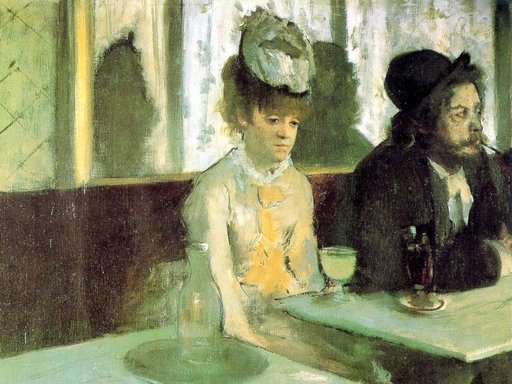
Degas painted L’Absinthe in 1875 initially it was panned by critics and went into storage several times.
The scene features a man and a woman in seated in a cafe drinking a glass of absinthe their expressions appear lethargic and sad.
For a women to be sat in a cafe drinking absinthe at the time was considered immoral.
Many British critics at the time were outraged by the work of art.
Degas unlike a lot of impressionist preferred urban setting for his painting and the female model in the picture is featured in his other works Plum Brandy and Chez le père Lathuille.
4. Pierre-Auguste Renoir
Pierre-Auguste Renoir was born in 1841 to a poor family in Limoges, France but moved to Paris near the Louvre. He embraced a brighter palette, focusing on intimate and candid subjects.
Aside from portraits, he captured the female nude body, but, in his later years, turned to domestic and rural scenes.
As a teenager, Renoir started an apprenticeship to a porcelain artist while studying drawing at a free art school. In 1864, The Paris Salon first accepted his work La Esmerelda.
After another piece was accepted at The Salon, he had enough recognition to commission portraits for individuals in order to help support himself.
Oftentimes, in order to remain financially stable, he would depend on family, friends, and patrons to help support him.
In 1870 Renoir was drafted into the army, but, thanks to him contracting dysentery, he never saw battle.
After the war, he returned to Paris and continued to work, gaining much notoriety for the Impressionist portraits he did.
In his later years he developed rheumatism which disfigured his hands and made working difficult for him.
He continued to work with a brush strapped to his fingers until his death in 1919.
His works feature everyday scenes of the people of Paris enjoying city life, many of the people in the paintings were his friends.
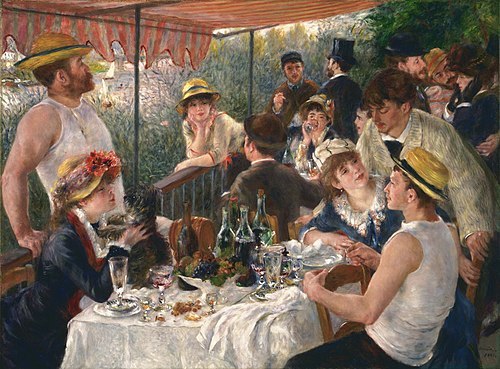
In the Luncheon of the Boating Party Pierre-Auguste Renoir displayed three of his favored styles of working: en plein air setting, portraiture and still life a combined with the painters refined brush work and exquisite color palette.
Luncheon of the Boating Party is Renoir’s most famous paintings and is one of his largest measuring 129.9cm x 172.7cm.
It features the artists friends and his future wife enjoying lunch on a balcony at the restaurant Maison Fournaise on the banks of the Seine in Chatou, France.
The hand rail serves as a cut off point between the empty left upper side of the picture which contains the river bank and the right hand side which is densely populated with figures.
5. Camille Pissarro
Camille Pissarro was born on the island of St. Thomas in 1830.
At the age of twelve, he was sent to boarding school near Paris where he was encouraged to draw.
When he returned, he worked at his father’s business, working on his art in his free time, paintings nature scenes.
He moved to Venezuela and found inspiration from its landscapes and villages. He moved to Paris but lasted a year before moving to the French countryside.
During the war, he fled to London, only to return and find many of his works destroyed by soldiers. He continued to work, developing and abandoning neo-impressionism throughout his adulthood.
Pissarro found the only things worth capturing were village life and landscapes. Instead of glorifying the scenes he worked on, he preferred to objectively chronicle.
Towards the end of his life, Pissarro developed an eye infection that made him unable to work outside unless it was warm.
He continued to work from hotel room windows that were high to see a broad view of the landscape out the window until he died in 1903.
Pissaro was a major proponent of en plein air or outside painting of landscapes.
This was one of the major impressionist painting techniques that set them apart from other genres as capturing the natural light was crucial.
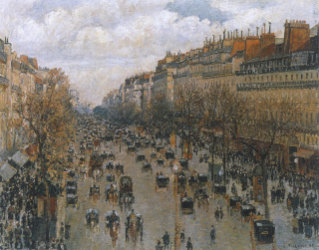
Towards the end of his life due to failing health he was forced to paint scenes from indoors. Many of which were of the Boulevart Montmartre painting the street in both night and day versions.
The painting is less concerned with the structure of the street and more with the interplay of light.
This is one of the reasons Pissaro would make several versions of his work including at night.
6. Mary Cassatt
Mary Cassatt was a life-long equal rights advocate, resenting the exclusion of women in the arts. Most of her work focused on the social and private lives of women and of mothers with their children.
Cassatt was born in Pennsylvania in 1844 to a well-to-do family. She traveled during her childhood, leading to her exposure to drawing while abroad.
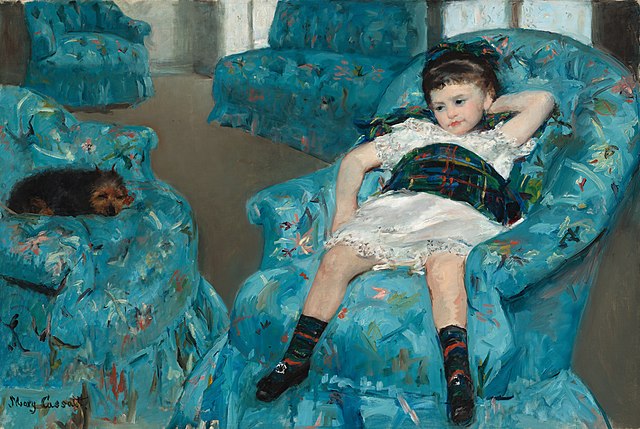
At the age of fifteen, she enrolled at Pennsylvania Academy of Fine Arts and studied art, to her father’s dismay. In her adult life, she moved to France and, due to females not welcome in most areas of artistic professions, she studied privately as a copyist.
Also Read: Famous Mary Cassatt Paintings
Once the war in France started, Cassatt returned to the United States and lived with her family, her father refused to assist in her aspirations.
After the war, she returned to France and had one of her works accepted into The Paris Salon.
After some professional success, she experienced a slump in her career, she was invited to join the Impressionists in their exhibition. It brought her more success which she enjoyed for the remainder of her life.
7. Alfred Sisley
Alfred Sisley was born to an affluent Breton family in Paris, France in 1839. After dropping out of business school in London, he pursued art school.
He met Claude Monet and Pierre-Auguste Renoir and would work with them en plein air.
Due to the unwelcome novel style of his work, the works he did rarely sold and were not displayed for a long time in The Paris Salon.
It wasn’t until 1868 that his first piece was accepted by The Salon, and he did not receive wide success or financial stability from it.
During the war in France, Sisley’s father’s business failed and his family lost all their money, requiring Sisley to depend on his artwork sales for sustenance.
His art did not rise in financial value until after his death and he experienced poverty until he died of throat cancer in 1899.
Throughout his life, Sisley was a strict adherent to creating his works outside. He focused on landscapes, more than any other impressionist artist, with the occasional deviation to figurative work.
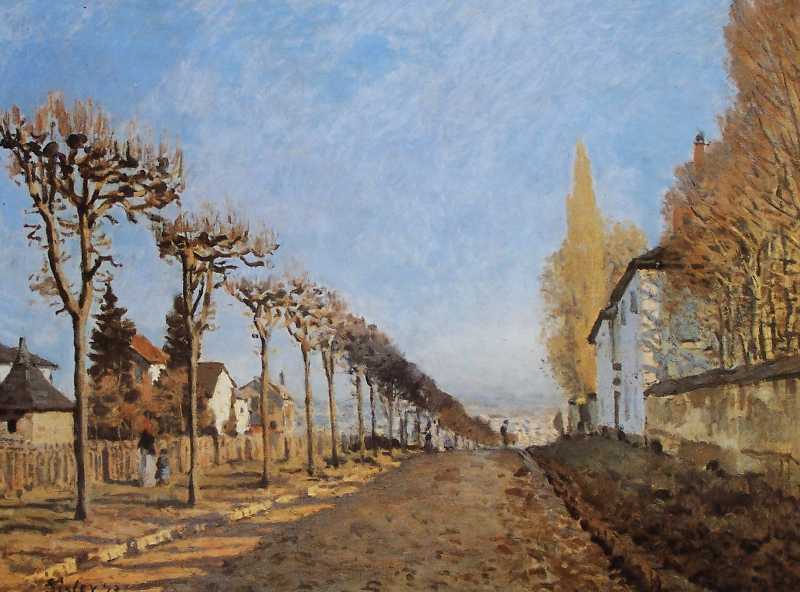
La Chemin de la Machine was painted by Alfred Sisley in 1873 and is one of the finest examples of en plein air painting.
Both Sisley and Monet would remain faithful to painting outside using the natural ever changing light conditions that the movement of the sun would produce as it moved through the sky over the course of the day and the seasons.
Like most of his work La Chemin de la Machine deals uses a soft and delicate color palette and the focal point of the painting is the disappearing road off into the distance.
This type of focal point was something that Sisley would use time and time again whether it be a road or a river.
A row of evenly planted trees encompass the side of the road which was and is to this day a common scene in small towns across France, which Sisley captures in a timeless sense.
His sky is lighter than those that Monet would paint and his later work would start to be influenced by Monet with the sky being the most noticeable progression in his work.
Impressionist Paintings
The impressionism paintings featured above heralded in a bold new movement in the art world.
Following on from realism the impressionist aimed to break from the traditional imagery in art that would depict the rich and powerful or religious scenes.
They aimed to capture the ordinary scenes and people of everyday life that surrounded them in both the countryside and the urban scenes of the larger French cities like Paris.
The impressionist sought to deal with color and it’s relationship with light as the major component of their work.
For the first time a large number of canvases were painted outside or en plein air. Natural light was considered the best way to explore how light and shadow interacted on the landscape.
Everyday life in the countryside was championed and celebrated, as was the common man.
This was a major step forward for French paintings at the time.
Impressionism should be see as one of the most important art movements ever and in many ways was the first true modern art.
Gone were the great historical scenes of old and the portraits of kings and noblemen replaced with nothing more than what the artists saw in the world around them.
Their work had a looser and lighter brushwork that allowed them to paint an “impression” of the scene with particular focus on how light interacted with the world around it.
The majority of the work was oil on canvas, some members of the movement would branch out into pointillism and other such techniques but it was the slow drying oil paint with brush that was used.
This collections of impressionist artists and paintings although not exhaustive covers the main protagonists in the movement and their works.

